Arles - A Medieval City
8-9 January 2007
Occupied first by Celtic tribes, then by a Greek colony, Arles became Roman when Julius Caesar gave the colony to the veterans of his legions. This resulted in the first golden age of Arles – Rome in Gaul. With the earliest days of Christianity the city becomes an important religious center. Destroyed and ravaged by invasions during the Middle Ages, Arles was rebuilt during the 12th century and the magnificence of its medieval monuments is evidence of the vitality and wealth of that period.
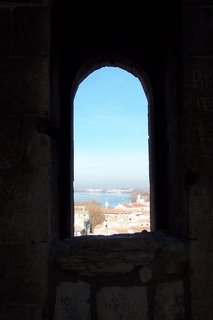 The centerpiece of Arles’ historical sites is the Roman Amphitheatre built about 80-90 AD. Built on the north side of the hill rising from the Rhône River,
The centerpiece of Arles’ historical sites is the Roman Amphitheatre built about 80-90 AD. Built on the north side of the hill rising from the Rhône River,
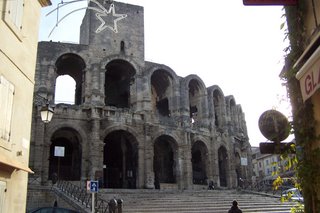
the amphitheatre was a natural focal point of the city as it dominated the landscape. Located on a vast platform cut out of the rock the amphitheatre is 136 meters long, 107 wide, has 60 arches and accommodates 20,000 people on its 34 tiers of seats.
107 wide, has 60 arches and accommodates 20,000 people on its 34 tiers of seats.
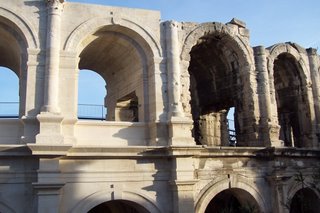
A portion of one façade has recently been restored and creates quite a contrast with the discoloured stone around it.
Its double ring of full height galleries, internal rings of lesser height and numerous staircases provide easy circulation. Add a dome and you would have a modern stadium.
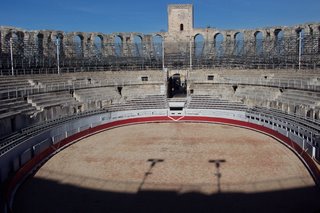
Entertainment took place on a raised wooden stage that could accommodate scenery and trapdoors and ramps were used to bring animals into the ring. The entertainment included fights between animals, between gladiators and animals and between gladiators. Recreations of hunting scenes were also popular. The upper rings of seats have been replaced by steel risers for modern spectators.
The stage wouldn’t leave much room to run from a lion or from a bull, not that you would as a gladiator.
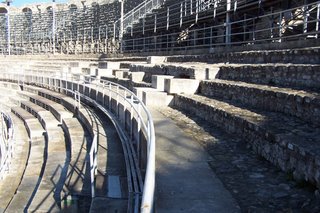 The "good" seats are smooth-faced slabs of rocks, while the "cheep" seats are samller peices of rock creating an uneven surface sure to numb your bum, unless you had a padded toga.
The "good" seats are smooth-faced slabs of rocks, while the "cheep" seats are samller peices of rock creating an uneven surface sure to numb your bum, unless you had a padded toga.

During the invasions of the Middle Ages, the amphitheatre, due to its strategic elevated location and its already thick, high walls, became a fortress and four towers were added to strengthen the defences,
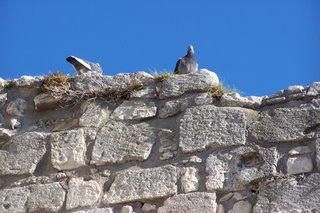
although with the passage of time the towers have become pigeon roosts.
Pigeons are an ongoing challenge in historical buildings. Their dung provides excellent fertilizer for small plants. The roots stabilize the soil in cracks, more soil accumulates and the cycle progresses, enlarging cracks and fissures.
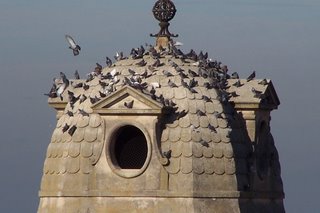 And the flocks grow, as seen in this shot of an adjoining tower.
And the flocks grow, as seen in this shot of an adjoining tower.
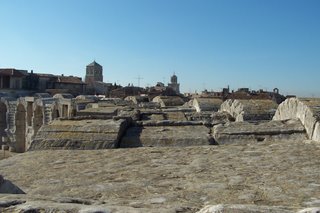
The covered portion of the amphitheatre boasts an interesting roof structure.
As time passed the amphitheatre as fortress became a place of residence. By the time it was cleared out and restorations were begun (1826-1830) it contained 212 houses and 2 churches. The first “modern” bullfights in the amphitheatre were organized in 1830 to celebrate the capture of the city of Algiers. Entertainment today includes a variety of music, and festivals.
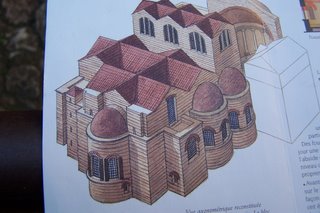 Less well preserved but still worth a visit, the Roman Public Baths date from about the 4th century. Public baths were an important feature of everyday life for Roman citizens – citizenship was not universal – and each afternoon, the women and then the men went through a dry ritual, followed by a hot bath, scraping of the skin, then a lukewarm bath followed by a cold bath and a massage. Sounds pretty good to us. This is an artist’s rendering of the baths.
Less well preserved but still worth a visit, the Roman Public Baths date from about the 4th century. Public baths were an important feature of everyday life for Roman citizens – citizenship was not universal – and each afternoon, the women and then the men went through a dry ritual, followed by a hot bath, scraping of the skin, then a lukewarm bath followed by a cold bath and a massage. Sounds pretty good to us. This is an artist’s rendering of the baths.
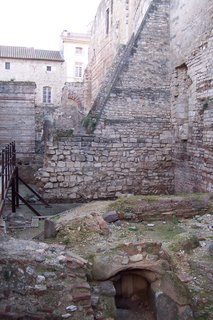 Today there are remnants of what was an extensive complex above the Rhône River. Some fireplaces are still evident
Today there are remnants of what was an extensive complex above the Rhône River. Some fireplaces are still evident
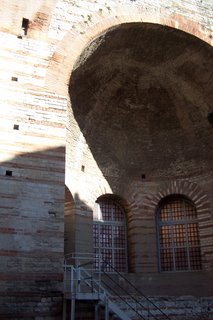 and much of the dome of the hot bath is still extant.
and much of the dome of the hot bath is still extant.
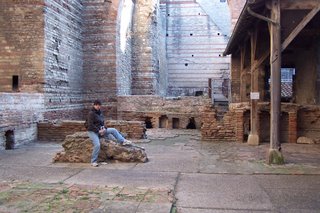
A partial arch of a linking dome can still be seen, to the right and behind the mermaid.
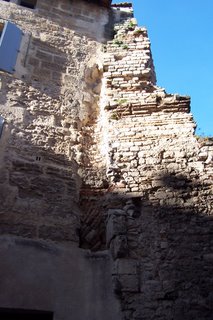
Many historic structures are ultimately covered by new structures built on top of them. In this case, houses have been built against portions of the baths.
Marie-Claire particularly liked the AMEX symbol in the window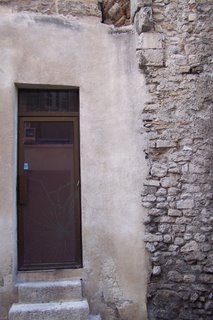 .
.
She has trouble finding places that take AMEX, so she wanted to run right in here and use it.
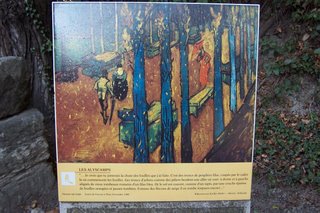 The Alyscamps of Arles were immortalized by Van Gogh.
The Alyscamps of Arles were immortalized by Van Gogh.
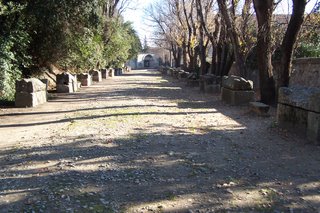
During the Roman period, cemeteries were often established outside the city walls along main roads. Cremation graves, sarcophagi and mausoleums spread out on both sides of the Via Aurelia.
The burial of the early Christian martyr Saint Genest gave the Alyscamps special importance resulting in its becoming a requisite stage on the San Juan de Compostello pilgrimage
Medieval poetry located Charlemagne’s battle against the Saracens in the Alyscamps to explain the abundance of graves and Dante immortalized it in the “Inferno”.
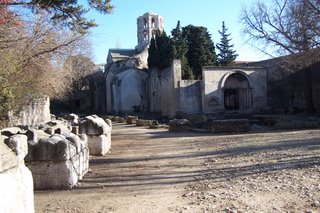 A chapel here sheltered the remains of the first Bishop of Arles and in 1040 the church became a priory dedicated to Saint Honorat.
A chapel here sheltered the remains of the first Bishop of Arles and in 1040 the church became a priory dedicated to Saint Honorat.
Rebuilt in the 12th century in Romanesque style it was crowned with the octagonal lantern tower seen here.
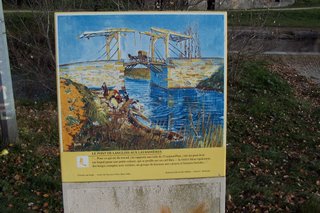
Van Gogh spent a significant portion of his later life in Arles and the Pont de Van Gogh still stands to the south of Arles.
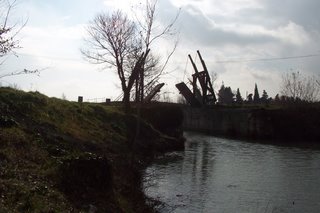
Today, his blue sky is missing as is the cart, the bridge is raised, a “modern” bridge has been added to one side and electrical wires intrude. But the bridge remains.
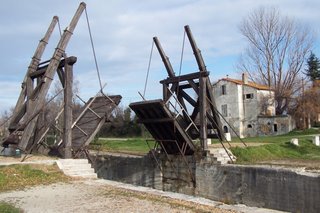
Now it might in reality be a bit like my great, great grandfather’s axe – the handle has been replaced 11 times, and the head 3 times – but it is still my great, great grandfather’s axe.
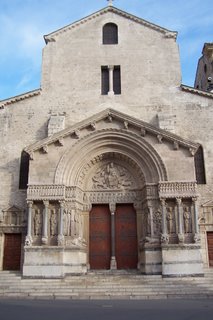 In the 5th century AD, Arles saw the construction of the first Episcopal complex. In the 12th century it was rebuilt with Saint-Trophime as the patron saint. It consists of the church, a cloister (built in the 12th and 14th centuries); the Bishop’s palace (built in the 12th century and rebuilt in the 17th).
In the 5th century AD, Arles saw the construction of the first Episcopal complex. In the 12th century it was rebuilt with Saint-Trophime as the patron saint. It consists of the church, a cloister (built in the 12th and 14th centuries); the Bishop’s palace (built in the 12th century and rebuilt in the 17th).
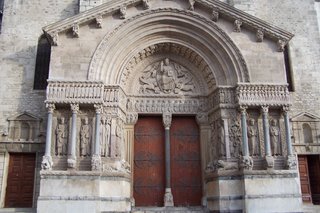 The Romanesque sculptures of the church portals are outstanding.
The Romanesque sculptures of the church portals are outstanding.
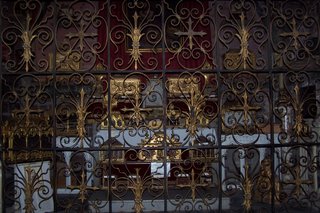 A number of relics can be found here.
A number of relics can be found here.
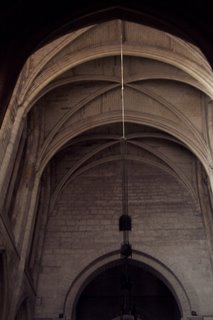
Already large and dramatic, Saint Trophime’s was enlarged with the construction of a Gothic choir in the 15th century.
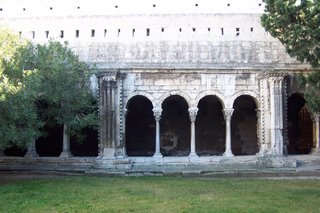
The cloister is used principally today for exhibitions. During our visit, the exhibition was based on representations of “la crêche”. Anyone following this blog has already seen lots of these so we will only include a few here.
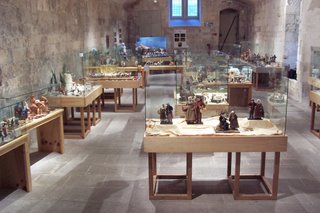 This overview shows about 1/3rd of the exhibition – this part in the refectory of the cloister.
This overview shows about 1/3rd of the exhibition – this part in the refectory of the cloister.
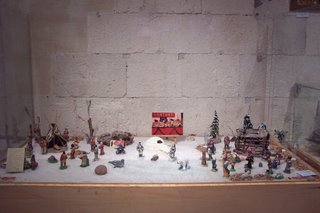
This one from Québec gets included because it so ably upholds our reputation as a nation of ice and snow – the unofficial “hymne national” of Québec comes to mind – “Mon pays, c’est n’est pas un pays – c’est l’hiver”.
This one makes the cut because it represents La Camargue.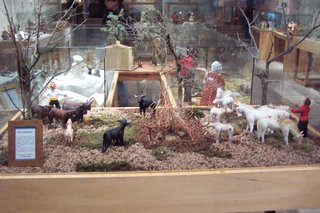
And this one from Italy has to be admired for its complexity.
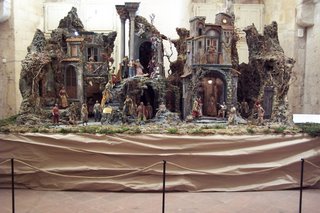
A few comments on Arles of today. For “camping-caristes” there are two camp grounds on the eastern exits of the city, and a rather noisy 24 hour parking on the northern exit near the train station – that’s it. We saw only 2 other motor homes while we were in Arles, and now we know why. In little, tiny Saintes-Maries-de-la-Mer, with its two quiet well serviced “aires de camping-cars” with water and sanitary facilities for disposal, we saw over 100 motor homes each day.
We would like to thank the attendant at the Cloister who stopped reading her book long enough to sell us admission tickets and the front line personnel in the Tourism Office who made us feel like we were intruding on their computer time. Others were a little more friendly. But in general Arles was the coldest place we have visited even though it was the warmest day of our trip.
Occupied first by Celtic tribes, then by a Greek colony, Arles became Roman when Julius Caesar gave the colony to the veterans of his legions. This resulted in the first golden age of Arles – Rome in Gaul. With the earliest days of Christianity the city becomes an important religious center. Destroyed and ravaged by invasions during the Middle Ages, Arles was rebuilt during the 12th century and the magnificence of its medieval monuments is evidence of the vitality and wealth of that period.
 The centerpiece of Arles’ historical sites is the Roman Amphitheatre built about 80-90 AD. Built on the north side of the hill rising from the Rhône River,
The centerpiece of Arles’ historical sites is the Roman Amphitheatre built about 80-90 AD. Built on the north side of the hill rising from the Rhône River,
the amphitheatre was a natural focal point of the city as it dominated the landscape. Located on a vast platform cut out of the rock the amphitheatre is 136 meters long,
 107 wide, has 60 arches and accommodates 20,000 people on its 34 tiers of seats.
107 wide, has 60 arches and accommodates 20,000 people on its 34 tiers of seats.
A portion of one façade has recently been restored and creates quite a contrast with the discoloured stone around it.
Its double ring of full height galleries, internal rings of lesser height and numerous staircases provide easy circulation. Add a dome and you would have a modern stadium.

Entertainment took place on a raised wooden stage that could accommodate scenery and trapdoors and ramps were used to bring animals into the ring. The entertainment included fights between animals, between gladiators and animals and between gladiators. Recreations of hunting scenes were also popular. The upper rings of seats have been replaced by steel risers for modern spectators.
The stage wouldn’t leave much room to run from a lion or from a bull, not that you would as a gladiator.
 The "good" seats are smooth-faced slabs of rocks, while the "cheep" seats are samller peices of rock creating an uneven surface sure to numb your bum, unless you had a padded toga.
The "good" seats are smooth-faced slabs of rocks, while the "cheep" seats are samller peices of rock creating an uneven surface sure to numb your bum, unless you had a padded toga.
During the invasions of the Middle Ages, the amphitheatre, due to its strategic elevated location and its already thick, high walls, became a fortress and four towers were added to strengthen the defences,

although with the passage of time the towers have become pigeon roosts.
Pigeons are an ongoing challenge in historical buildings. Their dung provides excellent fertilizer for small plants. The roots stabilize the soil in cracks, more soil accumulates and the cycle progresses, enlarging cracks and fissures.
 And the flocks grow, as seen in this shot of an adjoining tower.
And the flocks grow, as seen in this shot of an adjoining tower.
The covered portion of the amphitheatre boasts an interesting roof structure.
As time passed the amphitheatre as fortress became a place of residence. By the time it was cleared out and restorations were begun (1826-1830) it contained 212 houses and 2 churches. The first “modern” bullfights in the amphitheatre were organized in 1830 to celebrate the capture of the city of Algiers. Entertainment today includes a variety of music, and festivals.
 Less well preserved but still worth a visit, the Roman Public Baths date from about the 4th century. Public baths were an important feature of everyday life for Roman citizens – citizenship was not universal – and each afternoon, the women and then the men went through a dry ritual, followed by a hot bath, scraping of the skin, then a lukewarm bath followed by a cold bath and a massage. Sounds pretty good to us. This is an artist’s rendering of the baths.
Less well preserved but still worth a visit, the Roman Public Baths date from about the 4th century. Public baths were an important feature of everyday life for Roman citizens – citizenship was not universal – and each afternoon, the women and then the men went through a dry ritual, followed by a hot bath, scraping of the skin, then a lukewarm bath followed by a cold bath and a massage. Sounds pretty good to us. This is an artist’s rendering of the baths. Today there are remnants of what was an extensive complex above the Rhône River. Some fireplaces are still evident
Today there are remnants of what was an extensive complex above the Rhône River. Some fireplaces are still evident and much of the dome of the hot bath is still extant.
and much of the dome of the hot bath is still extant.
A partial arch of a linking dome can still be seen, to the right and behind the mermaid.

Many historic structures are ultimately covered by new structures built on top of them. In this case, houses have been built against portions of the baths.
Marie-Claire particularly liked the AMEX symbol in the window
 .
.She has trouble finding places that take AMEX, so she wanted to run right in here and use it.
 The Alyscamps of Arles were immortalized by Van Gogh.
The Alyscamps of Arles were immortalized by Van Gogh.
During the Roman period, cemeteries were often established outside the city walls along main roads. Cremation graves, sarcophagi and mausoleums spread out on both sides of the Via Aurelia.
The burial of the early Christian martyr Saint Genest gave the Alyscamps special importance resulting in its becoming a requisite stage on the San Juan de Compostello pilgrimage
Medieval poetry located Charlemagne’s battle against the Saracens in the Alyscamps to explain the abundance of graves and Dante immortalized it in the “Inferno”.
 A chapel here sheltered the remains of the first Bishop of Arles and in 1040 the church became a priory dedicated to Saint Honorat.
A chapel here sheltered the remains of the first Bishop of Arles and in 1040 the church became a priory dedicated to Saint Honorat.Rebuilt in the 12th century in Romanesque style it was crowned with the octagonal lantern tower seen here.

Van Gogh spent a significant portion of his later life in Arles and the Pont de Van Gogh still stands to the south of Arles.

Today, his blue sky is missing as is the cart, the bridge is raised, a “modern” bridge has been added to one side and electrical wires intrude. But the bridge remains.

Now it might in reality be a bit like my great, great grandfather’s axe – the handle has been replaced 11 times, and the head 3 times – but it is still my great, great grandfather’s axe.
 In the 5th century AD, Arles saw the construction of the first Episcopal complex. In the 12th century it was rebuilt with Saint-Trophime as the patron saint. It consists of the church, a cloister (built in the 12th and 14th centuries); the Bishop’s palace (built in the 12th century and rebuilt in the 17th).
In the 5th century AD, Arles saw the construction of the first Episcopal complex. In the 12th century it was rebuilt with Saint-Trophime as the patron saint. It consists of the church, a cloister (built in the 12th and 14th centuries); the Bishop’s palace (built in the 12th century and rebuilt in the 17th). The Romanesque sculptures of the church portals are outstanding.
The Romanesque sculptures of the church portals are outstanding. A number of relics can be found here.
A number of relics can be found here.
Already large and dramatic, Saint Trophime’s was enlarged with the construction of a Gothic choir in the 15th century.

The cloister is used principally today for exhibitions. During our visit, the exhibition was based on representations of “la crêche”. Anyone following this blog has already seen lots of these so we will only include a few here.
 This overview shows about 1/3rd of the exhibition – this part in the refectory of the cloister.
This overview shows about 1/3rd of the exhibition – this part in the refectory of the cloister.
This one from Québec gets included because it so ably upholds our reputation as a nation of ice and snow – the unofficial “hymne national” of Québec comes to mind – “Mon pays, c’est n’est pas un pays – c’est l’hiver”.
This one makes the cut because it represents La Camargue.

And this one from Italy has to be admired for its complexity.

A few comments on Arles of today. For “camping-caristes” there are two camp grounds on the eastern exits of the city, and a rather noisy 24 hour parking on the northern exit near the train station – that’s it. We saw only 2 other motor homes while we were in Arles, and now we know why. In little, tiny Saintes-Maries-de-la-Mer, with its two quiet well serviced “aires de camping-cars” with water and sanitary facilities for disposal, we saw over 100 motor homes each day.
We would like to thank the attendant at the Cloister who stopped reading her book long enough to sell us admission tickets and the front line personnel in the Tourism Office who made us feel like we were intruding on their computer time. Others were a little more friendly. But in general Arles was the coldest place we have visited even though it was the warmest day of our trip.


<< Home